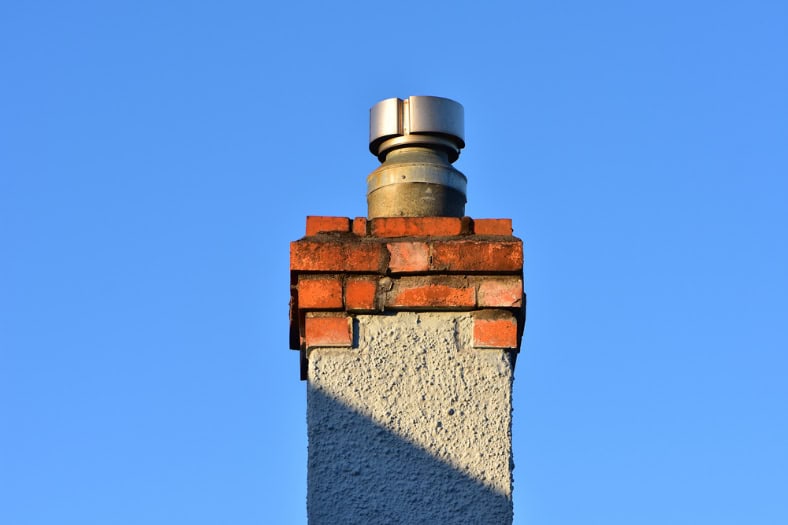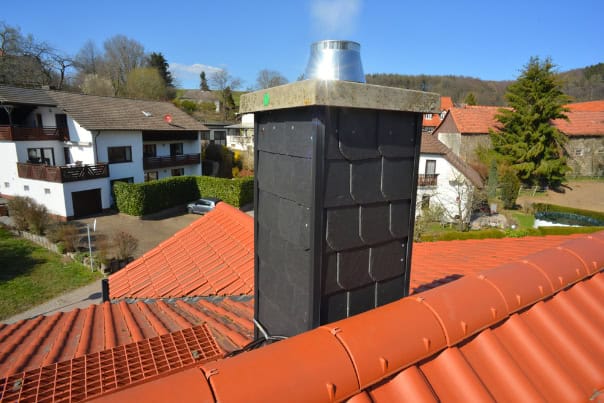
Summary:
The most obvious indicators of liner problems are things you can actually see. Take a flashlight and look up into your fireplace – you’re checking for physical damage that compromises your liner’s ability to protect your home.
Cracks are the biggest red flag. Even hairline fractures can allow deadly carbon monoxide to seep into your living space instead of venting safely outside. In Rhode Island’s freeze-thaw climate, small cracks quickly become dangerous gaps.
You might also notice pieces of clay tile or dark flakes scattered in your fireplace. This debris means your liner is literally falling apart, creating openings where heat and gases can escape into your chimney walls.

White chalky stains on your chimney’s exterior might look harmless, but they’re actually a warning sign called efflorescence. This happens when moisture gets where it shouldn’t be – often through a damaged liner – and pulls salts through your masonry as it evaporates.
For metal liners, rust is your enemy. Rhode Island’s coastal air and humid conditions accelerate corrosion, especially when moisture penetrates your chimney system. What starts as small rust spots quickly spreads, weakening the entire liner structure.
The combination of salt air from the coast and acidic combustion gases creates a perfect recipe for rapid deterioration. Many homeowners are surprised how quickly a liner can go from “slightly rusty” to “completely compromised” in our climate.
Water stains around your fireplace or chimney base also signal trouble. A properly functioning liner should keep moisture out, so any water intrusion suggests your protective barrier has failed. Don’t ignore these signs – water damage only gets worse over time, and the longer you wait, the more expensive repairs become.
Sometimes liner problems show up in how your fireplace or heating system performs rather than what you can see. Poor draft is a classic symptom – when smoke doesn’t rise up the chimney properly or backs up into your room, it often means your liner can’t create the proper airflow.
You might notice your fireplace doesn’t draw as well as it used to, or that smoke occasionally puffs back into the room when you first light a fire. This happens because damaged liners disrupt the smooth flow of gases up your chimney.
Strange odors are another telltale sign. A musty smell coming from your fireplace, especially during humid weather, suggests moisture is getting into places it shouldn’t. Strong smoke odors when your fireplace isn’t in use can indicate that gases are escaping through cracks instead of venting properly.
Cold drafts coming down your chimney when it’s not in use signal that your liner isn’t sealing properly. A good liner should prevent outside air from flowing down into your home, so persistent drafts mean there are gaps or damage allowing air infiltration.
Energy efficiency problems also point to liner issues. If your heating bills have crept up without explanation, a damaged liner might be letting warm air escape up your chimney instead of heating your home.
Want live answers?
Connect with a Certified Chimney Inspections expert for fast, friendly support.
Not all chimney liners handle Rhode Island’s climate equally well. Our harsh winters, freeze-thaw cycles, and coastal moisture create challenges that eliminate many liner options before you even consider cost or installation complexity.
Stainless steel liners outperform other materials in our specific conditions. They resist corrosion from salt air, handle temperature extremes without cracking, and maintain their structural integrity through decades of New England weather.
Clay tiles, common in older Rhode Island homes, simply can’t handle the thermal stress of our climate. They crack from freeze-thaw cycles and become expensive to repair or replace, especially in chimneys with bends or offsets.

Rhode Island’s location creates a perfect storm of conditions that test chimney liners to their limits. Our coastal position means salt air constantly attacks metal components, while our continental climate delivers temperature swings that stress even the most durable materials.
Winter temperatures regularly drop below freezing, then warm up enough to create freeze-thaw cycles that crack clay and ceramic liners. This repeated expansion and contraction is especially hard on older installations that weren’t designed for modern heating demands.
Humidity is another factor many homeowners underestimate. Our coastal moisture combines with combustion byproducts to create acidic conditions inside chimneys. Over time, this acidic environment eats away at inferior liner materials, creating safety hazards and performance problems.
Spring and fall weather changes happen quickly in Rhode Island, creating rapid temperature fluctuations that stress liner joints and connections. Materials that seem fine during stable weather can fail when subjected to our variable climate patterns.
The combination of these factors means that liner materials that work fine in other regions often fail prematurely here. Stainless steel’s resistance to both corrosion and thermal stress makes it the clear choice for Rhode Island installations.
Investing in a quality stainless steel liner pays dividends beyond just safety. These systems typically last 15-20 years with proper maintenance, compared to aluminum liners that might need replacement in just 5 years due to our corrosive coastal environment.
The improved draft performance of stainless steel liners can cut your heating costs by up to 15%. Better airflow means more efficient combustion and less wasted energy going up your chimney. Over the liner’s lifespan, these energy savings can offset a significant portion of the installation cost.
Maintenance is simpler too. The smooth, round interior of stainless steel liners makes annual cleaning faster and more thorough. Less creosote buildup means reduced fire risk and lower maintenance costs over time.
Insurance companies and home buyers also recognize the value of proper liner installation. Many insurers require proof of code-compliant installation, and a quality liner installation can actually increase your home’s resale value.
The flexibility of stainless steel liners makes them suitable for Rhode Island’s many older homes with non-straight chimneys. Whether your chimney has bends, offsets, or unusual configurations, flexible stainless steel can navigate these challenges where rigid materials cannot.
Most importantly, you get peace of mind knowing your system meets current safety codes and will protect your family through many more Rhode Island winters. The upfront investment in quality materials and professional installation prevents the much higher costs of emergency repairs or, worse, fire damage.
Don’t wait until you smell smoke in your living room or see chunks of liner falling into your fireplace. The warning signs we’ve covered – cracks, rust, poor draft, strange odors, and performance problems – all indicate it’s time to take action.
Rhode Island’s unique climate demands quality materials and professional installation. Stainless steel liners installed by licensed, certified technicians provide the durability and safety your family deserves.
When you’re ready to protect your home with a properly installed chimney liner, contact us at Certified Chimney Inspections. Our CSI-certified technicians understand Rhode Island’s specific challenges and use only the highest quality materials designed for our coastal climate.